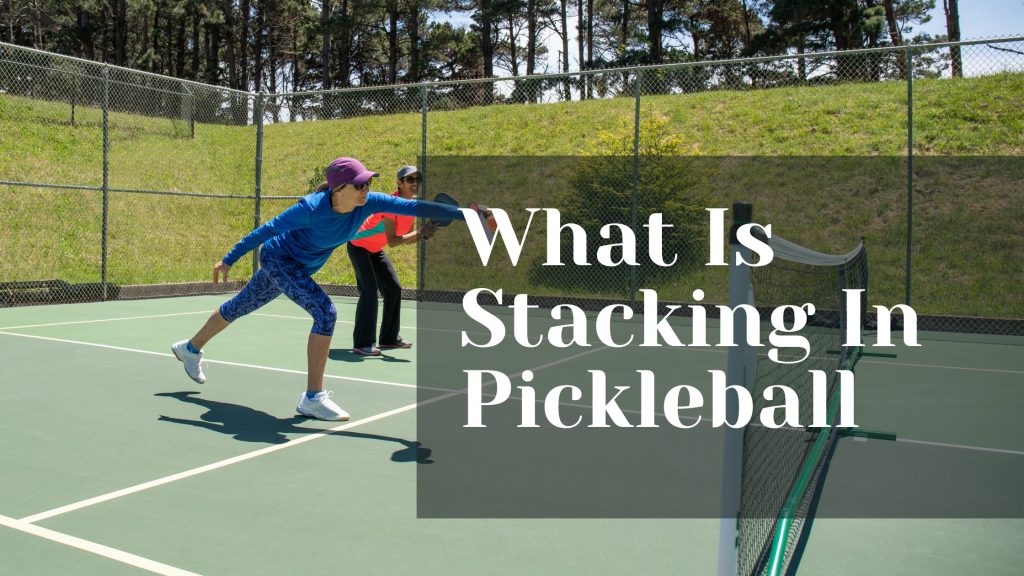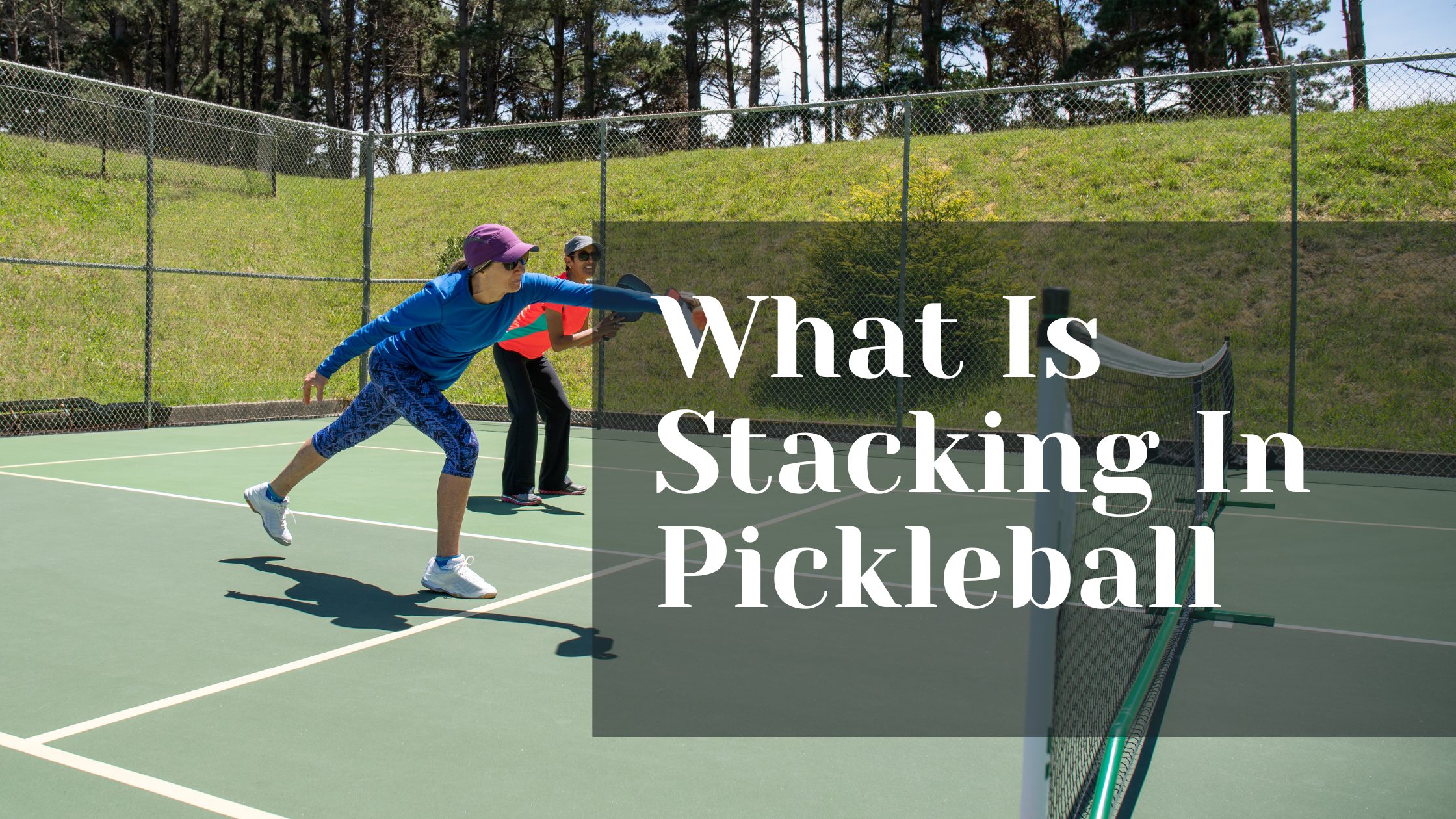Are you looking to up your pickleball game? Stacking is a great way to give you a competitive edge. Stacking is when two players team up to create two different defensive strategies that work together and are designed to counter their opponent’s strategy and give them an advantage. This blog will explore what is stacking in pickleball, the types of stacking, the techniques used, and the benefits of mastering this skill. So, whether you’re a novice or an experienced player, you’ll find something of value here. Let’s dive into the world of pickleball stacking!
What Is Stacking In Pickleball

Pickleball Stacking Definition
Stacking in pickleball is a strategy used in doubles play, where one player stays on one side of the court while their partner moves to the opposite side. This allows the team to cover more of the court and makes it more difficult for the opposing team to hit the ball.
What Stacking Entails
Stacking entails one player remaining on one side of the court while their partner moves to the opposite side. This creates more excellent court coverage and makes it harder for the opposing team to hit the ball. It is important to note that stacking is used primarily in doubles play and is unsuitable for singles play. It’s also important that stacking is used in conjunction with other tactics, such as good shot selection, proper footwork and positioning, and effective communication with your partner. Communication is crucial for executing the strategy effectively.
Can We Use Stacking In Doubles And Singles Play?
Stacking is primarily used in doubles play in pickleball as it allows one player to stay on one side of the court while their partner moves to the opposite side, creating greater coverage of the court and making it harder for the opposing team to hit the ball. This allows the team to better control the pace of the game and makes it more difficult for their opponents to score points.
In singles play, stacking is not typically used as it is a strategy designed for doubles play, where there are two players on each side of the court. A single player does not have the luxury of having a partner to cover one side of the court while they cover the other. In singles, players tend to focus on their own shots, footwork and positioning on the court to outplay their opponents.
Types of Stacking
As a good strategy player, one must know the different types of stacking available in a game and how to use them to their advantage.

Offensive Stacking
Offensive stacking is when players are placed close together on the court and are more aggressive in their play. This stacking is often used to pressure the opposition and force them out of their comfort zone. The benefit is that it gives the team more control over the court and the play, allowing them to dictate the pace and flow of the game. The downside is that it can be difficult to control the whole court at once, as players need to be aware of the other’s position and movements.
Defensive Stacking
Defensive stacking is the opposite of offensive stacking, as players are placed further apart on the court and are less aggressive in their play. This type of stacking is often used when the team is looking to slow the game’s pace and give the opposition less time to think and strategize. The advantage is that it allows the team to play a steady, controlled game, making it difficult for the opposition to break down. The downside is that the team may struggle to maintain control of the game and may find themselves on the back foot.
Mixed Stacking
Mixed stacking is a combination of both offensive and defensive stacking. It is often used when the team is trying to maintain a balance of both offensive and defensive play. The advantage of mixed stacking is that it allows the team to have more control over the court while still being able to adjust their strategy and be aggressive when needed. The downside is that it can be difficult to keep track of who is doing what, and the team can be caught off guard if the opposition is quick to adjust.
No matter which type you choose, remember that stacking is just one part of a successful pickleball strategy!
Strategies for Stacking
Here are some strategies for stacking in pickleball that can help you become a stronger player.
Take the time to understand your team’s strengths and weaknesses, prioritize your strategies, and practice your skills so you can quickly react and adjust to any situation. With a little bit of practice and the right strategies, you can become a force to be reckoned with on the pickleball court.
Benefits Of Stacking
One of the key benefits of stacking in pickleball is improved control. Stacking allows you to control your shots by positioning your body and racquet in the optimal spot to send the ball in the desired direction. This technique requires you to get low and keep your centre of gravity low, allowing you to generate power and accuracy. By stacking, you’ll be able to hit with greater precision and consistency, making it easier to control your shots.
Another major benefit of stacking in pickleball is enhanced accuracy. Stacking allows you to reduce the movement in your shots and helps you control the ball’s direction better. This can lead to fewer mistakes and greater accuracy from your shots. This technique can help you keep the ball within the court boundaries, making it easier to hit the ball in the desired direction.
Stacking in pickleball can help you increase spin. When you stack, you’re able to control the direction of your shots better, allowing you to put a spin on the ball. This can help you keep the ball low and away from your opponent’s reach, making it difficult for them to return it. Applying spin to your shots will open up more angles and create different opportunities.
Common mistakes to avoid when stacking
Unfortunately, many players make common mistakes when attempting to stack, resulting in defeat. The following are some of the common mistakes to avoid when stacking in pickleball:
Stacking is all about positioning and angles, but it requires you to be able to adjust to the style and level of your opponents. If you are playing a higher-level opponent, you will need to be more aggressive and aggressive in your stacking, while playing a lower-level opponent requires you to be more conservative and defensive in your stacking.
Stacking is a team effort and requires good communication between the two players stacked. Make sure to talk and strategize together to make sure you are both on the same page and working together.
It is easy to become too focused on stacking and neglect other areas of the court, such as serving or returning. Make sure to keep your focus on the entire court and not just the areas where you are stacking.
By avoiding these common mistakes, you will be able to become a more prosperous and efficient pickleball player.
FAQs
Final Verdict
Stacking in pickleball is a strategy where one player stays on one side of the court while the other partner moves to the opposite side to cover more of the court and make it harder for the opposing team to hit the ball. However, it must be combined with other tactics and a good understanding of the game to be effective. It’s important to be aware of the risks and potential drawbacks of stacking and adjust accordingly to best suit the match.
